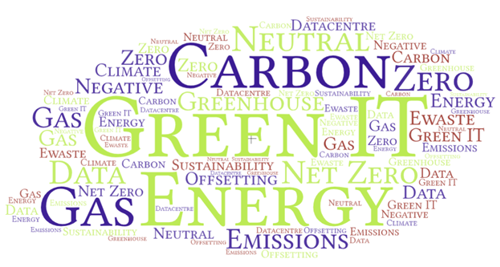Using devices, making photographs and enjoying movies all contribute to global warming. Beverly Clarke NPQSL CITP MBCS, BCS National Community Manager explores this topic with pupils and children.
Human activity is changing the climate and damaging the environment. Sea level changes, rising temperatures, loss of wildlife, issues with plastic affecting wildlife – globally these, any many more, are major topics of concern.
These changes are being driven by the way in which we as humans are using our planet. Globally, one way in which these issues are being addressed is through the United Nations (UN) Climate Change Conference - COP26.
With my computing education hat on, I find myself thinking about how technology impacts upon our world and the possible outcomes from this conference in addressing technology issues in line with the COP26 goals of:
- Secure global net zero by mid-century and keep 1.5 degrees within reach
- Adapt to protect communities and natural habitats
- Mobilise finance
- Work together to deliver
‘I am reflecting upon if some of the things that I noticed at the onset of the pandemic will be addressed, to ensure that we don’t add even more to this major problem.’
In particular, I am reflecting upon if some of the things that I noticed at the onset of the pandemic will be addressed, to ensure that we don’t add even more to this major problem. As a world, the pandemic hastened a move towards increased use of technology as a means of communication and of working, this has undoubtedly had an impact on the increase in e-waste and energy consumption. This is a major ethical, moral and social problem.
Many news sources are already reporting on this issue. Recently, Dispatches ran a feature which focused on the habits of humans and how these are destroying the planet. What habits I hear you ask? Below I delve into these further.
Technology’s part in climate change
Through our increased use of technology, we are utilising data centres and data centres are using a lot of power. We should ask ourselves. How are these datacentres being powered? Is the energy they are using from a renewable source? If not, then as a planet we are replacing one problem with another.
Earth Day came and went in April this year and is marked every year. The theme this year was #RestoreOurEarth – but what does this actually mean in practice? We are led to believe that we are saving the planet by not travelling and by switching to conferencing software, however when making statements that online is better for the planet, there are a few things to consider, some of which are:
- the number of people on the call;
- the location of those people on the call;
- the quality of the call (is it streaming in HD video?).
Why are these things important? The answer is simple, if there are, say, fifty people on a call from across the globe, then all of the data being generated is being routed around the world through data centres and a lot of energy is being used up.
Also, if all of those people are using video, it is more energy-hungry than using audio alone. There is a tipping point between the benefits of online only vs in-person
What about another area of our lives, taking photos or videos? These two activities use a lot of energy, especially when the image or video is then shared with others around the world. Consider if a photo is taken in England and shared with thousands of people around the world – that photo has been routed around the planet, through lots of data centres. Lots of energy is being used, the further the image travels. Consider social media and the number of posts individuals and companies make on a daily basis, all of these are travelling through data centres and using energy, yet for the most part this is not visible to the user.
For you
Be part of something bigger, join BCS, The Chartered Institute for IT.
Invisible but still using energy
Many of our devices when not in use are in “standby” mode, this utilises some energy. A worthwhile exercise would be to look around our homes at how many devices are in standby mode or permanently connected and consider the energy impact.
With my reflective hat on and in the role which I have at Computing at School (CAS), I started to think about discussions we could have with ourselves, pupils and other adults around this topic and came up with the items that now follow:
- Help learners to talk about the cloud and where it is. The cloud is a physical entity. Show them images of data centres to make this real and to appreciate where the data we generate everyday goes.
- Develop the above point and ask learners how many photos and videos they have on their devices. Ask them where those items are stored; this can be further extended as a whole class, year group or whole school exercise to really appreciate the amount of data being used and sent. across ‘the cloud’ and where data centres fit with energy consumption. I did this activity and found that I had 7,163 photos and 304 videos on my phone.
Then, when speaking with a friend, he had 13,493 photos and 421 videos. The question which then arose was, where are they all stored and what is the impact upon our planet?
- Ask learners to find out/research about any local data centres and to be aware of data centres in their communities/area and other countries.
- Ask how many data centres there currently are in the world, then develop this into a discussion around language pertaining to data centres, such as sensors, storage devices, cabling, infrastructure – this helps with connecting the theory of computing to real world examples.
- Ask learners to reflect upon how many devices they use that are connected to the internet of things (IoT).
- Ask parents/guardians/family/friends and consider for ourselves how our habits have changed pre and post pandemic, with online usage.
- Consider what happens to electronic devices when they are no longer in use? This is e-waste, where does it all go? What is the effect of e-waste on communities, countries and the planet?
This can then be added to some of the points and tips that came out of watching the Dispatches programme:
- look at websites and see what their commitment is to GreenIT and the planet, consider the companies that we all support and their pledges to the planet;
- think about the resolution of images being shared, higher resolution images use more energy;
- turn devices off when not in use;
- reduce the amount of time you spend online;
- consider how much time you spend streaming/online gaming, with the aim of reducing this time;
- use just audio instead of video as this will save on energy;
- use WiFi over 3G/4G/5G as WiFi uses less energy;
- unplug at the weekend for a great work life balance and to help the planet.
To support teachers with this issue, CAS has produced the Climate Champions resources for Primary school teachers and educators through the Barefoot Computing Programme.
We have also partnered with Adobe Spark to run a cross curricular writing challenge combining computing and literacy aimed at 11-14 year olds, for them to consider their impact upon the planet.
In summary, the lists and resources above are not exhaustive, but I feel they provide a good starting point for activity, discussion and reflection. In my opinion, we all should play our small part in ensuring that we are #OneStepGreener and having an awareness and understanding of our usage of electronic devices is part of the way forward.
Further interest around GreenIT
- BCS: GreenIT Specialist Member Group and Green IT web page
- Dispatches: Online Habits killing the planet
- BBC News: Ditch 4K video and new tech to fight climate change
- WordCloud - Created by Beverly Clarke


















